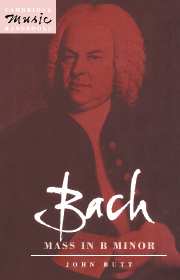Book contents
- Frontmatter
- Contents
- Preface
- List of abbreviations
- 1 The musical genre of the mass Ordinary
- 2 Genesis and purpose
- 3 Reception history
- 4 Text and music: the process of adaptation and composition
- 5 Ritornello forms
- 6 The influence of the dance
- 7 Counterpoint
- 8 Figurae and the motivic texture
- 9 Patterns and proportions: large-scale structuring and continuity in the Mass in B Minor
- Afterword
- Notes
- Select bibliography
- Index
9 - Patterns and proportions: large-scale structuring and continuity in the Mass in B Minor
Published online by Cambridge University Press: 05 June 2012
- Frontmatter
- Contents
- Preface
- List of abbreviations
- 1 The musical genre of the mass Ordinary
- 2 Genesis and purpose
- 3 Reception history
- 4 Text and music: the process of adaptation and composition
- 5 Ritornello forms
- 6 The influence of the dance
- 7 Counterpoint
- 8 Figurae and the motivic texture
- 9 Patterns and proportions: large-scale structuring and continuity in the Mass in B Minor
- Afterword
- Notes
- Select bibliography
- Index
Summary
Each of the four sections of the Mass in B Minor (with the exception of the Sanctus of 1724) contains music originally composed for other purposes, but Bach – remarkably – moulded the material to form a coherent sequence of movements. Such are the similarities of musical style and the formal correspondences between the four sections that these in turn form a larger unity, the missa tola. The overall balance of keys is an important unifying factor, as are the motivic and structural links between movements.
The Missa of 1733 (Kyrie and Gloria)
When Bach presented the Missa to the Elector of Saxony in 1733 it is unlikely that he considered this to constitute only the first section of an unfinished missa tota. Quite clearly the Missa should be viewed as a complete and independent work with its own proportions and unifying elements. The solo numbers in the Gloria section utilise all five voices, and each of the instrumental families is represented in turn.
Figure 4 demonstrates in particular the symmetrical structure of the Gloria section: this begins and ends with paired movements, where the final chord of the first of each pair opens the ensuing piece (‘Gloria in excelsis Deo'/Et in terra’ – ‘Quoniam’/‘Cum sancto Spiritu’). Another paired group is placed just beyond its midway point (‘Domine Deus’/‘Qui tollis’). These paired units themselves have a carefully proportioned design (even though each component is of different origins).
- Type
- Chapter
- Information
- Bach: Mass in B Minor , pp. 92 - 101Publisher: Cambridge University PressPrint publication year: 1991

